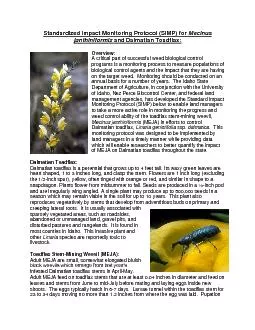

for Mecinus janthi ni formi s and Dalmatian Toadflax Overview A critical part of successful weed biological control programs is a monitoring process to measure populations of biological control ID: 847844
Download Pdf The PPT/PDF document "Standardized Impact Monitoring Protocol ..." is the property of its rightful owner. Permission is granted to download and print the materials on this web site for personal, non-commercial use only, and to display it on your personal computer provided you do not modify the materials and that you retain all copyright notices contained in the materials. By downloading content from our website, you accept the terms of this agreement.
1 Standardized Impact Monitoring Protocol
Standardized Impact Monitoring Protocol (SIMP) for Mecinus janthi ni formi s and Dalmatian Toadflax: Overview: A critical part of successful weed biological control programs is a monitoring process to measure populations of biological control agents and the impa ct that they are having annual basis for a number of years. The Idaho State Department of Agriculture, in conjunction with the University of Idah o, Nez Perce Biocontrol Center, and federal land man agement agencies, has developed t he Standard Impact Monitoring Protocol (SIMP) below to enable land managers to take a more active role in monitoring the progress and weed control ability of the toadflax stem - mining weevil, Mecinus janthiniformis (MEJA) in effo rts to control Dalmatian toadflax, Linaria genistifolia ssp . dalmatica . This monitoring protocol was designed to be implemented by land managers in a timely manner while providing data of MEJA on Dalmatian toadflax throughout the state . Dalmatian Toadflax: Dalmatian toadflax is a perennial that grows up to 4 feet tall. It s w axy green leaves are heart shaped, 1 to 3 inches long, and clasp the stem. Flowers are 1 inch long (excluding the 1/2 - inch a snapdragon. Plants flower from midsummer to fall. Seeds are produced in a ½ - inch pod and are irregularly wing angled. A single plant may produce up to 500,000 seeds in a season which may remain viable in the soil for up to 10 years . This plant also creeping lateral roots. It is usually associated with sparsely vegetated areas, such as roadsides, aban doned or unmanaged land, gravel pits, and disturbed pastures and rangelands. It is found in most counties in Idaho. This invasive plant and other Linaria species are reportedly toxic to livestock. Toadflax Stem - Mining Weevil (MEJA): Adult MEJA are smal l, somewhat elongated bluish black weevils which emerge from last yearâs infested Dalmatian toadflax stems in April - May. Adult MEJA feed on toadflax stems that are at least 0.04 inches in diameter and feed on leaves and from June to mid - July before mating and laying eggs inside new shoot s. The eggs typically hatch in 6 - 7 days. L arvae tunne
2 l within the toadflax stem for 23 to
l within the toadflax stem for 23 to 34 days moving no more than 1.2 inches from where the egg was laid . Pupation 20 m 2 4 6 8 10 12 14 16 18 20 Post or rebar location Permanent marker locations 4 m 0 m 50 cm 25 cm Permanent markers occurs within the stem . Adult feeding on stems and leaves has a limited impact on the plant . L arval mining impacts the plants by causing premature wilting of shoots and suppressing flower formation. MEJA overwinter as adults inside their pupation chamber. The effects of the weevil on the plant are reportedly enhanced under drought stress . Monitoring : SIMP is based upon a permanent 20 meter vegetation sampling transect randomly placed in a suitable (at least 1 acre) infestation of Dalmatian toadflax and timed counts of MEJA adults . Annual vegetat ion sampling will allow researchers to characterize the plant community and the abundance and vigor of Dalmatian toadflax . Visual counts of MEJA adults will provide researchers with an estimate of MEJA population levels. Permanent Site Set - up: To set up the vegetation monitoring transect , you will need: 1) a 25 x 50 cm Daubenmire frame made from PVC (preferred) or rebar, 2) a 20 m tape measure for the transect and plant height, 3) 10 permanent markers (road whiskers and 16 penny nails â see picture be low) , 4) a post (stake or piece of rebar) to monument the site (see pictures for examples of field equipment), and 5) 30 - 45 minutes at the site during the week before Memorial Day . To set up the transect , place the 20 m tape randomly within the infestatio n. Mark the beginning of the transect with a post. Place permanent markers every 2 m (for a total of 10 markers) beginning at the 2 m mark and ending with the 20 m mark on the tape measure . Place the Daubenmire frame parallel to the tape on the 50 cm si de with the permanent marker in the upper left corner starting at 2 m (see pictures). Refer to the data collection sheet for how to conduct monitoring. Repeat the frame placement at 2 m intervals for a total of 10 measurement s (one at each permanent mark er) .